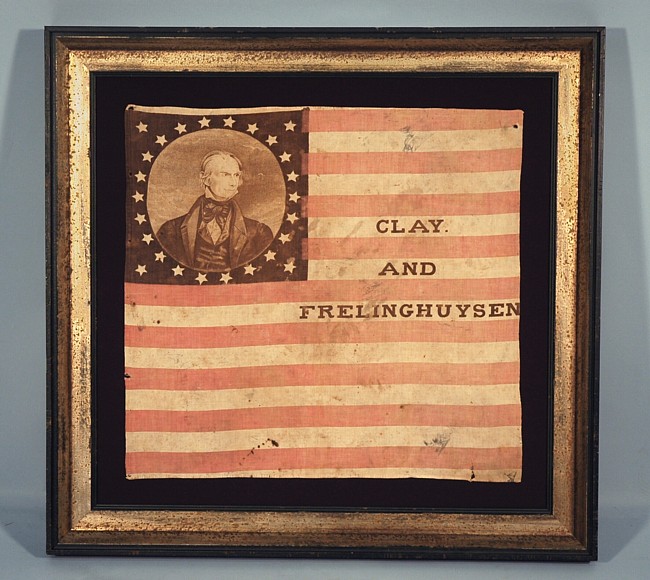
| |
26 STAR PORTRAITPARADE FLAG FROM THE 1844 PRESIDENTIAL CAMPAIGN OF HENRY CLAY |
|
| Available: |
Sold |
| Frame Size (H x L): |
35" x 36.5" |
| Flag Size (H x L): |
25"x 26.5" |
|
| Description....: |
|
RARE, PORTRAIT-STYLE PARADE FLAG FROM THE 1844 PRESIDENTIAL CAMPAIGN OF HENRY CLAY, 26 STARS:
26 star American parade flag, printed on cotton, made for the 1844 campaign of Henry Clay. Clay's portrait appears inside a wreath of stars, and overprinted in the stripes are the words: "Clay And Freylinghuysen"
The 26 star flag became official on July 3rd, 1837, after the addition of Michigan. It remained the official star count until 1845. The earliest known parade flags have either 26 or 13 stars, and were made within this 8-year period. Parade flags do exist from the 1840 campaign of William Henry Harrison, and while the Clay/Polk campaign was four years later, in 1844, this still means the Henry Clay campaign flags, while not the first, are still among the earliest printed parade flags known to exist. Further, political campaign flags are among the most valuable of all Stars and Stripes. This is a particularly visual example with great folk characteristics. Among these are its circular star pattern and interesting portrait with exaggerated features. It is likely that the flag's square proportions, its original form, were made to mimic infantry battle flags and other military standards, most of which had this shape.
Take specific note that the flag has 17 stripes instead of the official 13. This may serve no particular purpose, as there are numerous early flags that do not have the correct stripe count. The choice of 17 vs. 13 may simply be due to the fact that the person who designed the flag liked it better that way from a graphics standpoint. But I think the number 17 had a particular meaning to Clay, who became a U.S. Senator in 1806, during the period in which we had 17 states. Clay was just 29 years old at the time. A special exception was made because he was younger than 30 years old, the minimum age required by Constitutional law. This was the beginning of a nearly uninterrupted 46-year term in the House and Senate, where he served as both Speaker and Chairman, respectively.
Clay's presidential campaign focused on the creation of a national currency, promotion of agriculture, and protection of American industry through such devices as protective tariffs. The focus was intended to further the advancement of America into the industrial age and limit reliance on foreign goods. As it turned out, this issue was not as important to Americans as westward expansion, which was the platform of the successful presidential candidate, James Polk.
It is interesting to note that the 1844 election was the first in which an incumbent president, John Tyler, sought nomination and didn't get it, which made Polk the Democrat's dark horse nominee. It is also interesting that Joseph Smith, who founded the Mormon Church in 1847, was the third candidate. No flags or textiles are known to exist from the Smith campaign.
Biographical Information on Clay and Frelinghuysen:
Henry Clay was born in Virginia on April 12th, 1777, about 2 months before the Stars & Stripes was adopted as the American national flag (June 14th). He studied law at Richmond and moved to Kentucky to practice. In addition to his 46 years in the House and Senate, Clay also served as Secretary of State for John Quincy Adams. He ran unsuccessfully for the presidency three times, first as a Democratic Republican in 1824, then as a National Republican in 1832, and finally as a Whig in 1844. After the last campaign he returned to the Senate, serving until his death in 1852.
Theodore Frelinghuysen was born in Franklin, NJ in 1787. Before he ran for vice president, he was an attorney, then a U.S. Senator serving New Jersey, then Mayor of Newark, then Chancellor of New York University. In 1850 he became President of Rutgers College, and remained in that position until his death in 1862. His grandson was Henry Cabot Lodge, Jr.
Mounting: The flag has been hand-stitched to 100% cotton, black in color. The cotton was washed to remove excess dye, and an acid-free agent was added to the wash to further set the dye. The flag was then placed in a black painted, hand-gilded and distressed Italian molding. The front is u.v. protective Plexiglas.
Condition: There is moderate foxing and staining and fading, accompanied my minor fabric loss. The rarity and desirability of this particular, pre-Civil War example warrants almost any condition, and this is very acceptable. |
|
|
|
| Collector Level: |
Flags for the truest Patriots. My best offerings |
|
| Flag Type: |
Parade flag |
|
| Star Count: |
26 |
|
| Earliest Date of Origin: |
1843 |
|
| Latest Date of Origin: |
1844 |
|
| State/Affiliation: |
Michigan |
|
| War Association: |
1777-1860 Pre-Civil War |
|
| Price: |
Sold |
|
| |
Views: 3741 |
|
|
|

